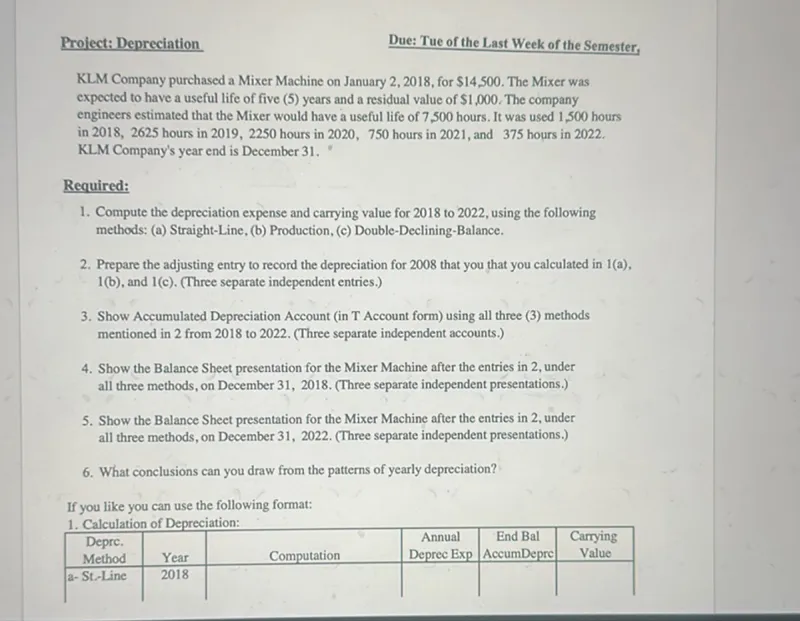Questions: KLM Company purchased a Mixer Machine on January 2, 2018, for 14,500. The Mixer was expected to have a useful life of five (5) years and a residual value of 1,000. The company engineers estimated that the Mixer would have a useful life of 7,500 hours. It was used 1,500 hours in 2018, 2625 hours in 2019, 2250 hours in 2020, 750 hours in 2021, and 375 hours in 2022. KLM Company's year end is December 31. Required: 1. Compute the depreciation expense and carrying value for 2018 to 2022, using the following methods: (a) Straight-Line, (b) Production, (c) Double-Declining-Balance. 2. Prepare the adjusting entry to record the depreciation for 2008 that you calculated in 1(a), 1(b), and 1(c). (Three separate independent entries.) 3. Show Accumulated Depreciation Account (in T Account form) using all three (3) methods mentioned in 2 from 2018 to 2022. (Three separate independent accounts.) 4. Show the Balance Sheet presentation for the Mixer Machine after the entries in 2, under all three methods, on December 31, 2018. (Three separate independent presentations.) 5. Show the Balance Sheet presentation for the Mixer Machine after the entries in 2, under all three methods, on December 31, 2022. (Three separate independent presentations.) 6. What conclusions can you draw from the patterns of yearly depreciation?

Transcript text: KLM Company purchased a Mixer Machine on January 2, 2018, for $14,500. The Mixer was expected to have a useful life of five (5) years and a residual value of $1,000. The company engineers estimated that the Mixer would have a useful life of 7,500 hours. It was used 1,500 hours in 2018, 2625 hours in 2019, 2250 hours in 2020, 750 hours in 2021, and 375 hours in 2022. KLM Company's year end is December 31.
Required:
1. Compute the depreciation expense and carrying value for 2018 to 2022, using the following methods: (a) Straight-Line, (b) Production, (c) Double-Declining-Balance.
2. Prepare the adjusting entry to record the depreciation for 2008 that you calculated in 1(a), 1(b), and 1(c). (Three separate independent entries.)
3. Show Accumulated Depreciation Account (in T Account form) using all three (3) methods mentioned in 2 from 2018 to 2022. (Three separate independent accounts.)
4. Show the Balance Sheet presentation for the Mixer Machine after the entries in 2, under all three methods, on December 31, 2018. (Three separate independent presentations.)
5. Show the Balance Sheet presentation for the Mixer Machine after the entries in 2, under all three methods, on December 31, 2022. (Three separate independent presentations.)
6. What conclusions can you draw from the patterns of yearly depreciation?





